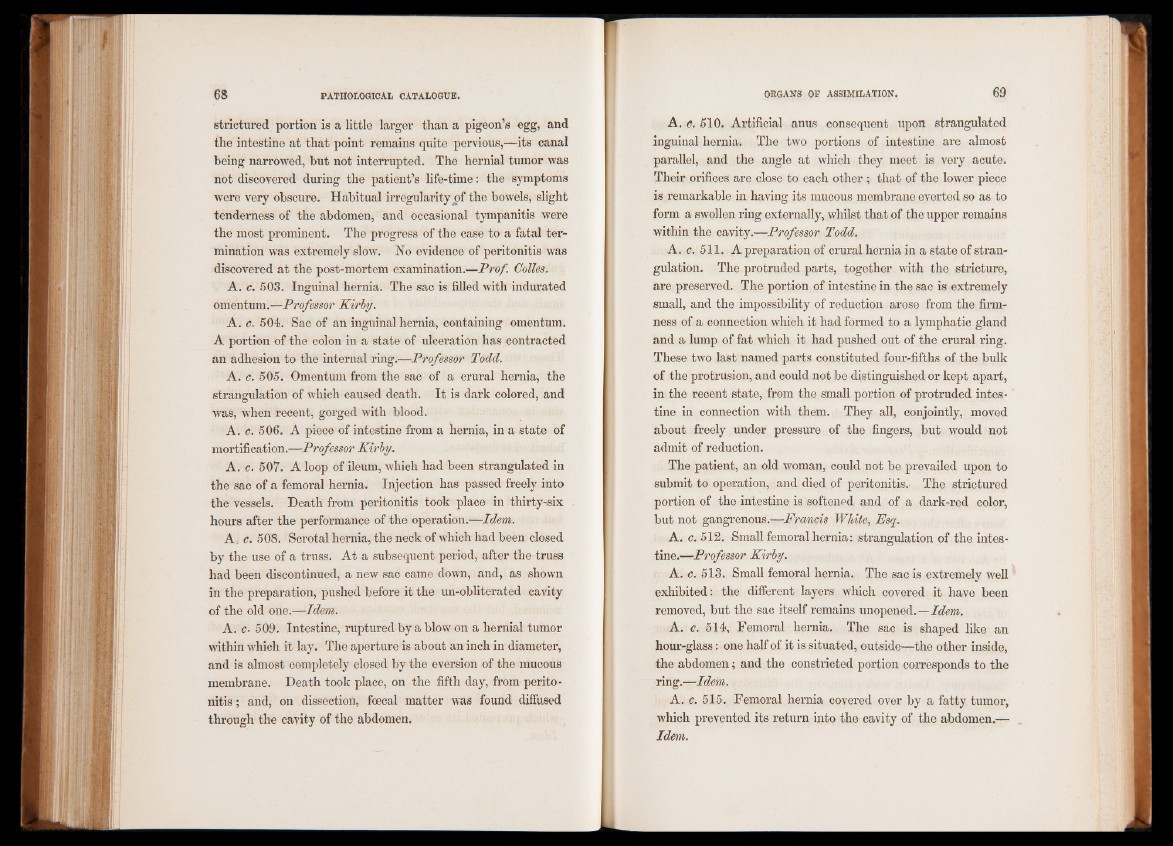
strictured portion is a little larger than a pigeon’s egg, and
the intestine at that point remains quite pervious,—its canal
being narrowed, but not interrupted. The hernial tumor was
not discovered during the patient’s life-time: the symptoms
were very obscure. Habitual irregularity of the bowels, slight
tenderness of the abdomen, and occasional tympanitis were
the most prominent. The progress of the case to a fatal termination
was extremely slow. No evidence of peritonitis was
discovered at the post-mortem examination.—Prof. Colies.
A. c. 503. Inguinal hernia. The sac is filled with indurated
omentum.—Professor Kirby.
A. c. 504. Sac of an inguinal hernia, containing omentum.
A portion of the colon in a state of ulceration has contracted
an adhesion to the internal ring.—Professor Todd.
A. c. 505. Omentum from the sac of a crural hernia, the
strangulation of which caused death. It is dark colored, and
was, when recent, gorged with blood.
A. c. 506. A piece of intestine from a hernia, in a state of
mortification.—Professor Kirby.
A. c. 507. A loop of ileum, which had been strangulated in
the sac of a femoral hernia. Injection has passed freely into
the vessels. Death from peritonitis took place in thirty-six
hours after the performance of the operation.—Idem.
A. c. 508. Scrotal hernia, the neck of which had been closed
by the use of a truss. At a subsequent period, after the truss
had been discontinued, a new sac came down, and, as shown
in the preparation, pushed before it the un-obliterated cavity
of the old one.—Idem.
A. c■ 509. Intestine, ruptured by a blow on a hernial tumor
within which it lay. The aperture is about an inch in diameter,
and is almost completely closed by the eversion of the mucous
membrane. Death took place, on the fifth day, from perito -
nitis; and, on dissection, foecal matter was found diffused
through the cavity of the abdomen.
A. c. 510. Artificial anus consequent upon strangulated
inguinal hernia. The two portions of intestine are almost
parallel, and the angle at which they meet is very acute.
Their orifices are close to each other ; that of the lower piece
is remarkable in having its mucous membrane everted so as to
form a swollen ring externally, whilst that of the upper remains
within the cavity.—Professor Todd.
A. c. 511. A preparation of crural hernia in a state of strangulation.
The protruded parts, together with the stricture,
are preserved. The portion of intestine in the sac is extremely
small, and the impossibility of reduction arose from the firmness
of a connection which it had formed to a lymphatic gland
and a lump of fat which it had pushed out of the crural ring.
These two last named parts constituted four-fifths of the bulk
of the protrusion, and could not be distinguished or kept apart,
in the recent state, from the small portion of protruded intestine
in connection with them. They all, conjointly, moved
about freely under pressure of the fingers, but would not
admit of reduction.
The patient, an old woman, could not be prevailed upon to
submit to operation, and died of peritonitis.’ The strictured
portion of the intestine is softened and of a dark-red color,
but not gangrenous.—Francis White, Esq.
A. c. 512. Small femoral hernia: strangulation of the intestine.—
Professor Kirby.
A. c. 513. Small femoral hernia. The sac is extremely well
exhibited: the different layers which covered it have been
removed, but the sac itself remains unopened.—Idem.
A. c. 514, Femoral hernia. The sac is shaped like an
hour-glass: one half of it is situated, outside—the other inside,
the abdomen; and the constricted portion corresponds to the
ring.—Idem.
A. c. 515. Femoral hernia covered over by a fatty tumor,
which prevented its return into the cavity of the abdomen.—
Idem.